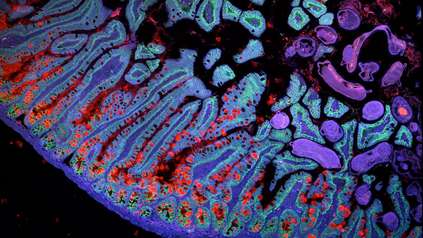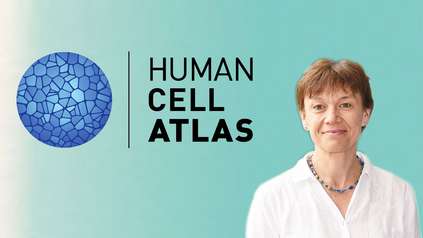Cell atlas reveals how blood and immune systems form in developing bone marrow
The first comprehensive analysis of how the blood and immune systems develop in prenatal bone marrow has been conducted by scientists at the Wellcome Sanger Institute, Newcastle University and their collaborators. The researchers found that in the space of just a few weeks, numerous blood and immune cell types emerge from developing bone marrow, including key white blood cells that protect against bacteria.
The study, published today (29 September 2021) in Nature, is part of the Human Cell Atlas (HCA) initiative to map every cell type in the human body, to transform our understanding of health, infection and disease1. It will be an important reference for understanding how the blood and immune systems develop in bone marrow, and how this can go wrong in disorders such as leukaemia, with important implications for diagnoses and treatments.
A previous HCA study described how the human blood and immune systems begin to develop in the yolk sac and liver, a process known as haematopoiesis. But until now, it was unknown how haematopoiesis continued in bone marrow, which produces blood and immune cells for the rest of the individual’s life.
Although the human blood and immune system generally protects us from infection and disease, the system can go wrong and lead to immune deficiencies and cancers such as leukaemia2.
In this study, researchers from the Wellcome Sanger Institute, Newcastle University, the University of Cambridge and the University of Oxford, used single cell RNA technology to analyse developing bone marrow tissue3 samples, in order to identify the cell types present and which genes those cells expressed.
The team observed the rapid diversification of blood and immune cells into specialist types, including white blood cells called neutrophils that protect against bacteria. This diversification occurred over six to seven weeks early in the second trimester of pregnancy. Compared to fetal liver, there were a large number of B-lymphoid cell types, which are needed both to help combat infection and to mount an effective response to vaccines.
“For the first time, we were able to identify all the blood and immune cells in developing bone marrow. This even allowed us to see the stromal cells – the environment that the immune cells develop in – which never been characterised in detail before. This atlas will be a huge resource for researchers.”
Dr Laura Jardine, a first author on the paper from Newcastle University
“However much we may have thought that we understood the immune system, it is actually far more complex than we had realised. Data like this provides the resolution needed to properly understand what is happening at a molecular level during development.”
Professor Muzlifah Haniffa, a senior author of the paper from the Wellcome Sanger Institute and Newcastle University
The researchers also studied Down syndrome bone marrow, identifying notable differences in gene expression that may help to shed light on why individuals with Down syndrome are more prone to developing immune disorders and leukaemia.
“We know that children with Down syndrome have a higher risk of developing leukaemia but we don’t know why. This study characterises some of the differences in gene expression in their bone marrow, which will allow us to start figuring out whether these differences are significant and in what way. We hope this will ultimately help researchers develop better ways of treating, or even preventing, leukaemia in these children.”
Professor Irene Roberts, a senior author of the paper from the MRC Molecular Haematology Unit at the University of Oxford
This research is part of the Human Developmental Cell Atlas (HDCA), which is creating an atlas of all cells that are important for healthy human development. Key to understanding what happens in early development and how this can affect health or lead to disease, the HDCA is likely to lead to transformations in healthcare.
“This first detailed map of developing bone marrow is another important contribution to the international Human Cell Atlas initiative, which aims to create an openly available human ‘Google map’ of the body to understand health and disease. It is helping to transform our understanding of how the human immune system develops in early life and is likely to lead to new ways of diagnosing and treating patients with immune diseases, including the potential for regenerative medicine.”
Dr Sarah Teichmann, a senior author of the study from the Wellcome Sanger Institute and co-chair of the Human Cell Atlas Organising Committee
More information
1The Human Cell Atlas (HCA) is an international collaborative consortium which is creating comprehensive reference maps of all human cells—the fundamental units of life—as a basis for understanding human health and for diagnosing, monitoring, and treating disease. The HCA will impact every aspect of biology and medicine, propelling translational discoveries and applications and ultimately leading to a new era of precision medicine. The HCA was co-founded in 2016 by Dr Sarah Teichmann at the Wellcome Sanger Institute (UK) and Dr Aviv Regev, then at the Broad Institute of MIT and Harvard (USA). A truly global initiative, there are now more than 2,000 HCA members, from 75 countries around the world. https://www.humancellatlas.org
2 Leukaemias are cancers that affect white blood cells. For more information on the various types of leukaemia, see the Cancer Research UK website.
3Developmental tissue was provided by the Human Developmental Biology Resource (HDBR), which provides human embryonic and fetal tissues to ethically approved scientific studies such as the Human Developmental Cell Atlas to enable research into understanding human development to help improve health.
Publication:
Laura Jardine and Simone Webb et al. (2021) Blood and immune development in human fetal bone marrow and Down syndrome. Nature. DOI: https://doi.org/10.1038/s41586-021-03929-x
Funding:
This research was funded by Wellcome, the Medical Research Council (MRC) and funding to individual authors. Please see the manuscript for full details.





